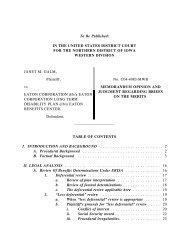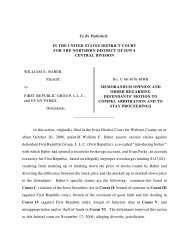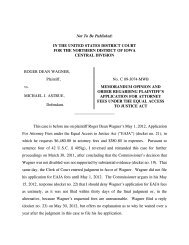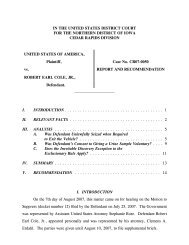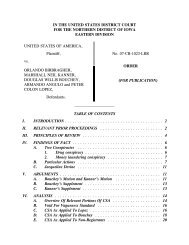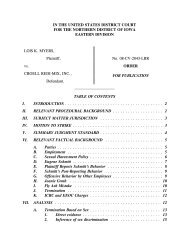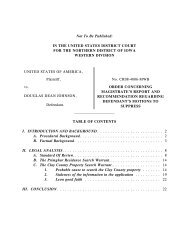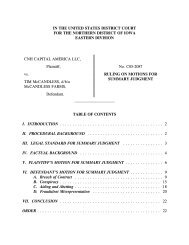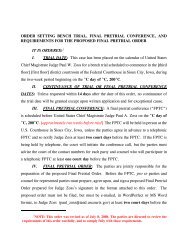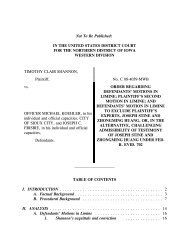Arnzen v. Palmer - Northern District of Iowa
Arnzen v. Palmer - Northern District of Iowa
Arnzen v. Palmer - Northern District of Iowa
You also want an ePaper? Increase the reach of your titles
YUMPU automatically turns print PDFs into web optimized ePapers that Google loves.
Neither we nor the Supreme Court have determined the<br />
appropriate standard for considering whether a particular<br />
search violates the Fourth Amendment rights <strong>of</strong> a person who<br />
is involuntarily civilly committed. We have, however,<br />
identified the constitutional standard applicable to an alleged<br />
violation <strong>of</strong> the Fourth Amendment rights <strong>of</strong> an involuntarily<br />
committed person based upon a seizure. See Andrews v. Neer,<br />
253 F.3d 1052, 1061 (8th Cir. 2001). The plaintiff in<br />
Andrews, who was lawfully involuntarily committed, brought<br />
a 42 U.S.C. § 1983 suit alleging that a seizure using excessive<br />
force violated his Fourth Amendment rights. Id. at 1055,<br />
1061. In a matter <strong>of</strong> first impression, we determined that such<br />
a Fourth Amendment seizure claim “should be evaluated under<br />
the . . . standard usually applied to excessive-force claims<br />
brought by pretrial detainees.” Id. at 1061.<br />
In making this determination, we considered whether<br />
involuntarily committed persons are more like arrestees,<br />
pretrial detainees, or convicted prisoners. Id. We concluded<br />
that the best analogy is to pretrial detainees because<br />
“confinement in a state institution raise[s] concerns similar to<br />
those raised by the housing <strong>of</strong> pretrial detainees, such as the<br />
legitimate institutional interest in the safety and security <strong>of</strong><br />
guards and other individuals in the facility, order within the<br />
facility, and the efficiency <strong>of</strong> the facility’s operations.” Id.<br />
Other circuits have relied upon Andrews in considering<br />
constitutional claims raised by involuntarily committed<br />
individuals. See, e.g., Hydrick v. Hunter, 500 F.3d 978,<br />
997-98 (9th Cir.2007); Davis v. Rennie, 264 F.3d 86, 102,<br />
108 (1st Cir.2001). But see Aiken v. Nixon, 236 F. Supp. 2d<br />
211, 236 (N.D.N.Y. 2002) (finding civilly committed persons<br />
akin to prison visitors for the purpose <strong>of</strong> considering the<br />
constitutionality <strong>of</strong> visual body-cavity searches), aff’d, 80 Fed.<br />
Appx. 146, 147 (2d Cir. 2003) (unpublished).<br />
The similarity in the grounds for detaining persons<br />
awaiting trial and persons determined to be sexually dangerous<br />
supports application <strong>of</strong> the analogy to pretrial detainees in the<br />
present case. One reason pretrial detainees are kept in custody<br />
6



